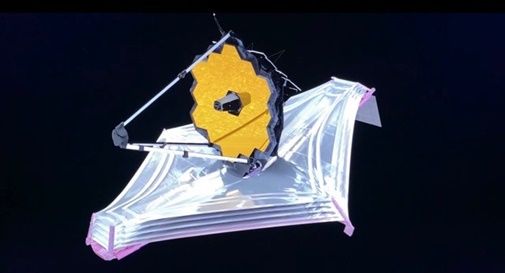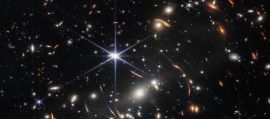Inizia l'implementazione del parasole del telescopio Webb
La parte più imprevedibile, critica e più rischiosa del viaggio del JWST, lo spiegamento dell'importantissimo scudo termico gigante, è iniziata.
| Richard Brewer |

Credito immagine: NASA/Goddard Space Flight Center Conceptual Image Lab
USA - Dopo il successo del lancio del telescopio spaziale James Webb (JWST o Webb) il giorno di Natale, l'array solare e l'antenna per le comunicazioni si sono dispiegate automaticamente. Questo è stato seguito da due bruciature di correzione a metà rotta di grande successo per spingere la traiettoria del veicolo spaziale verso la sua destinazione a 1,5 milioni di km dalla Terra. Dopo aver sorvolato l'orbita della luna a 384.400 chilometri dalla Terra e aver viaggiato a 1 km/secondo, è stato avviato l'importantissimo dispiegamento dello schermo solare.
Martedì 28 dicembre, tre giorni dopo il lancio, è iniziata una delle parti più imprevedibili, critiche e rischiose del suo viaggio: il complesso compito di aprire il fragile parasole. Il parasole deve essere dispiegato, separato e tenuto teso e mentre JWST ha molti primati significativi, il parasole è sicuramente uno dei principali ostacoli da superare. Il guasto di uno solo dei 107 meccanismi di rilascio (perni che si ritraggono come gli artigli di un gatto), 90 cavi o decine di pulegge coinvolti in questo processo potrebbero mettere a repentaglio l'intera missione Webb.
Sono stati attivati vari riscaldatori per riscaldare i componenti chiave del dispiegamento e martedì sono stati inviati i comandi dal controllo a terra per abbassare prima le strutture del pallet di prua e poi di poppa (posteriore) che tengono il parasole ripiegato. Questo ha segnato l'inizio di almeno altri cinque giorni di attività di implementazione della protezione solare e rappresenta l'inizio di tutte le principali implementazioni a venire.
Il parasole con una superficie di 150 metri quadrati (1600 piedi quadrati) e su cui poggia il destino del telescopio è costituito da cinque strati di materiale molto sottile chiamato Kapton. Ogni strato è spesso solo quanto un capello umano e questo rende il dispiegarsi nello spazio un affare intrinsecamente rischioso. Il tessuto è impossibile da controllare perfettamente o da prevedere i suoi movimenti e se si impiglia mentre si dispiega l'intero telescopio si trasforma in spazzatura spaziale.
Aprire senza problemi il grande parasole è un problema molto difficile. Mentre è facile prevedere il movimento di qualcosa di rigido, come un pannello con una cerniera, è quasi impossibile prevedere la forma di qualcosa di floscio come un lenzuolo sul tuo letto se spingi su di esso o su uno qualsiasi dei fili come i cavi che si mettono in tensione il parasole, tutti hanno molti modi diversi in cui possono muoversi... e quando metti tutto questo in un ambiente a gravità zero, tutto quel materiale può andare dove semplicemente non vuoi che vada. Il problema è stato risolto piegandolo in una piega a fisarmonica a forma di "Z" e tenendolo in posizione finché non è pronto per essere aperto con 107 perni retrattili.
Il materiale della protezione solare si restringe quando fa più freddo e gli strati caldi si espandono. Il Kapton minimizza questo problema e analisi e test hanno permesso di fare previsioni sulla forma che assumerà nello spazio. L'ottica del telescopio deve essere protetta dall'esposizione diretta a qualsiasi oggetto caldo quindi lo schermo è stato dimensionato e posizionato in modo che gli specchi siano esposti solo al lato freddo dello schermo mentre il sole splende direttamente solo sul lato anteriore. Gli strati sono stati rinforzati ogni sei piedi circa per fungere da "rip stop" nel caso in cui si verifichi un buco in uno strato a causa di una piccola meteora che lo colpisce.
Il dispiegamento del parasole attualmente in corso dovrebbe essere completato entro domenica 2 gennaio 2022, dopodiché possono iniziare i compiti per dispiegare i grandi specchi dorati … seguirà un altro periodo di ansia. Il telescopio è diretto verso la sua orbita di destinazione, nota come L2, a circa 1,5 milioni di chilometri dalla Terra dove dovrebbe arrivare entro la fine di gennaio.
Quindi inizierà un processo di cinque mesi di allineamento dello specchio e calibrazione dello strumento e, in seguito a queste attività, il James Webb Space Telescope sarà in grado di iniziare il suo tanto atteso lavoro scientifico che dovrebbe espandere la comprensione umana dell'universo.

**************** ENGLISH **************
The Webb Telescope Sunshield Deployment Begins
The most unpredictable, critical and riskiest part of the JWST's journey, the unfolding of the all-important giant heat shield has started.
USA - After the successful launch of the James Webb Space Telescope (JWST or Webb) on Christmas Day the solar array and communications antenna automatically deployed. This was followed by two very successful midcourse correction burns to nudge the spacecraft's trajectory toward its destination 1.5 million km from Earth. After flying past the moon’s orbit at 384,400 kilometers from Earth and traveling at 1 km/second, the all important deployment of the sunshield was initiated.
On Tuesday, 28 December, three days after launch one of the most unpredictable, critical and riskiest parts of its journey began: the complex task of unfolding the fragile sunshield. The sunshield must be unfurled, separated and held taut and while JWST has many significant firsts, the sunshield is definitely one of the major hurdles to overcome. The failure of just one of the 107 release mechanisms (pins that retract like a cat’s claws), 90 cables or dozens of pulleys involved in this process could jeopardize the entire Webb mission.
Various heaters were activated to warm key deployment components and on Tuesday the commands from ground control were sent to first lower the forward and then the aft (rear) pallet structures that hold the folded up sunshield. This marked the beginning of at least five more days of sunshield deployment tasks and represents the start of all major deployments to come.
The sunshield with an area of 150 square meters (1600 square feet) and on which the telescope’s fate rests is made of five layers of very thin material called Kapton. Each layer is only as thick as a human hair and this makes unfolding in space an inherently risky affair. Fabric is impossible to perfectly control or to predict its movements and if it snags as it unfurls the whole telescope turns into space junk.
Smoothly unfolding the large sunshield is a very tough problem. While it is easy to predict the motion of something rigid, like a panel with a hinge, it is nearly impossible to predict the shape of something floppy like a sheet on your bed if you push on it or any of the string like cables that tension the sunshield, all have many different ways they can move … and when you place all this in zero-G environment all that material can go places you just don't want it to go. The problem was addressed by folding it up into a “Z” shaped accordion fold and holding it in place until it’s ready to unfold with 107 retractable pins.
The material of the sunscreen does shrink when it gets colder and the hot layers will expand. The Kapton minimizes this and analysis and testing have allowed predictions to be made of the shape it will assume in space. The telescope optics must be protected from direct exposure to any hot objects so the shield has been sized and positioned so that the mirrors will only be exposed to the cold side of the shield while the sun only directly shines on the front side. The layers have been reinforced every six feet or so to act as a “rip stop” in case a hole occurs in a layer due to a small meteor striking it.
The deployment of the sunshield currently underway is expected to be completed by Sunday, January 2, 2022 after which the tasks to unfold the large golden mirrors can begin … yet another anxiety inducing period will ensue. The telescope is headed towards its destination orbit, known as L2, about 1.5 million kilometers from Earth where is expected to arrive by the end of January.
Then a five month process of mirror alignment and instrument calibration will begin and following these activities the James Webb Space Telescope will be able to start its highly anticipated scientific work that is expected to expand human understanding of the universe.








